Environmental Effects
Environmental Effects
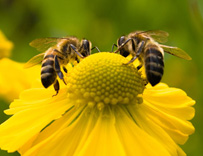
An ever-increasing number of studies, as well as much anecdotal evidence, points to the harm that wireless frequencies are causing to our environment. The combined effects of wireless radiation on pollinators (including bees and butterflies) and food plants, along with the degradation of our food supply caused by GMOs, are creating a perfect storm for the collapse of the food supply and of the world’s ecosystems.
Since the installation of smart meters in Ann Arbor in 2012, I have seen almost no bees. The numbers were already dropping precipitously, and this seems to have been their death knell. That same year, almost no toads. Every year since, the numbers have been minimal. Starting in the summer of 2012, I found that the bugs that are tiny enough to fly through the holes in your window screens were no longer a problem. Where did they all go? I wondered, then realized it must be the smart meters. When I go walking Bird Hills Nature Area, I see thousands of flowers but only 0–7 insects during my half-hour walk. This was not the case prior to smart meter installation. This year, some of the plants are bearing almost no fruit—likely because the pollinators they require are gone.
Radiofrequency affects the ability of insects to navigate. Navigation systems are critical to the survival of birds, insects, and earthworms, to name just a few.
Here we present a few of the scientific studies. First, a word about the environmental community and smart meters.

Nothing can escape it unless we act.
Environmentalists Speak Out
Sadly, most of the environmental community is unaware of the harm caused by smart meters and other forms of wireless radiation. Nonetheless, a few environmentalists both groups and individuals, have taken a stand. The co-founder of the National Resources Defense Council, Whitney North Seymour, attorney, environmentalist, and former state senator, is one of them. Sadly, the organization he co-founded, the NRDC, has jumped on the false “smart meters are green” bandwagon.
See a video of Seymour speaking about smart meters.
Former EPA attorney Jonathan Libber has taken a strong stand against the meters as president of Maryland Smart Meter Awareness. He points out our country’s spotty record of figuring out environmental hazards before they’re widespread. Libber was a skeptic at first. When a concerned neighbor approached him about the meters, Libber’s response was, "Ah, some kind of stuff from California. Whatever. I initially was not that impressed." That would have been the end of it for Libber, except that a friend kept pressing him on the issue, eventually getting him to read about 150 pages of documents. That convinced him, and he joins the ranks of others, like Dr. Martin Blank of Columbia University and former Microsoft Canada president Frank Clegg in opposing the meters because of the harm they cause humans and the environment. Read more at the Baltimore Sun.

Says Linda Kurtz, head of the Smart Meter Education Network: “The larger environmental community likely has not come out against smart meters for a number of reasons. First, these meters—and all the other wireless devices—have been touted as ‘green’ and energy-saving. Nothing could be further from the truth, as we discuss on our page, “Do Smart Meters Really Save Energy? Secondly, the environmental community has not heard about the negative health and environmental impacts of wireless and digital technologies, mainly because information about these meters has largely been disseminated by conservative and libertarian groups that, in general, do not support the goals of and are not in communication with environmentalists. I feel very fortunate that I, as an environmentalist, have had the opportunity to learn about the negative consequences of these meters on our environment. Third, like most people, so many environmentalists are in love with these technologies and don’t want to give them up, no matter what harm they are causing to the environment. Therefore, they dismiss any reports they do receive about the meters. I have contacted a variety of environmental organizations about these meters. They have not even bothered to acknowledge my emails or phone calls. Finally, guess who sits on the boards of some of the largest environmental organizations? The very people who stand to make the most money from this technology. For instance, Wendy Schmidt, wife of the Google CEO, sits on the board of the NRDC. Ann Doerr, wife of venture capitalist John Doerr (who sits on Google’s board), serves on the board of the Environmental Defense Fund. I don't doubt these people’s commitment on one level, but it is a commitment that ends once their own personal pleasure or wealth is impacted.”
One of the few environmental groups that has taken a stand against smart meters is the San Francisco Sierra Club.
Plants
Scientific and Lay Studies on Effect of Microwave Frequencies on Plants
The first studies were by high school students and grade-schoolers. Now, scientists are weighing in.
Read more: Read Ph.D. thesis here. Journal abstract: Influence of microwave frequency electromagnetic radiation on terpene emission and content in aromatic plants. Influence of environmental stress factors on both crop and wild plants of nutritional value is an important research topic. The past research has focused on rising temperatures, drought, soil salinity and toxicity, but the potential effects of increased environmental contamination by human-generated electromagnetic radiation on plants have little been studied. Here we studied the influence of microwave irradiation at bands corresponding to wireless router (WLAN) and mobile devices (GSM) on leaf anatomy, essential oil content and volatile emissions in Petroselinum crispum, Apium graveolens and Anethum graveolens. Microwave irradiation resulted in thinner cell walls, smaller chloroplasts and mitochondria, and enhanced emissions of volatile compounds, in particular, monoterpenes and green leaf volatiles (GLV). These effects were stronger for WLAN-frequency microwaves. Essential oil content was enhanced by GSM-frequency microwaves, but the effect of WLAN-frequency microwaves was inhibitory. There was a direct relationship between microwave-induced structural and chemical modifications of the three plant species studied. These data collectively demonstrate that human-generated microwave pollution can potentially constitute a stress to the plants.Read more...
An Extensive List of Studies Shows Effects. Click here for a list of additional studies showing effects on plants, from tomatoes to barley, from gene expression to perturbation of natural rhythms.
Science Experiment by Grade-Schooler Shows That W-Fi Is Causing
His Headaches and Deforms Growing Seeds
His Headaches and Deforms Growing Seeds
cress seeds after noticing that when they slept with their cellphones near their heads overnight, they had trouble focusing the next day. The picture from their experiment tells the story: The cress seeds alongside the routers did not grow at all, mutated, or died. Aiden Fitch found the same thing. He grew one set of seeds at home, next to a laptop computer without wireless. He grew the second set in a home that has wireless. The seeds grown next to the wireless router were deformed.
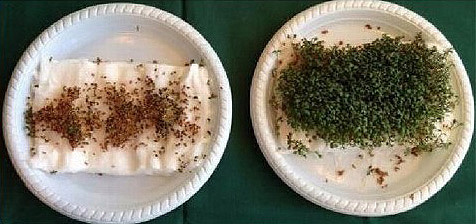 The sprouts tasted different as well. Garden cress is a fast-growing herb with a peppery, tangy flavor and smell. The seed which grew in a home without wireless tasted strong and peppery—so much so that Aiden had to run for a glass of water. The Wi-Fi seeds tasted "like water," Aiden said.
The sprouts tasted different as well. Garden cress is a fast-growing herb with a peppery, tangy flavor and smell. The seed which grew in a home without wireless tasted strong and peppery—so much so that Aiden had to run for a glass of water. The Wi-Fi seeds tasted "like water," Aiden said.
The Danish science experiment has attracted international attention from leading biologists and radiation experts, including Olle Johanssen, and may have us rethinking the proliferation of wireless devices in our homes.
Oh my...what's in WiFi?
Second grader patterns science fair project after Danish experiment
Tri-City Times Online
by Catherine Minolli
April 02, 2014
ALMONT — When the school district rolled out the Ipads this year, Aiden Fitchett noticed something new; as he did when seated near the wireless projector any time a teacher used one for a presentation: headaches. Bad ones. Bad enough that the 8-year-old second grader would come home crying from the pain.
His mom, biologist Rachel Fitchett, made a correlation between Aiden's headaches and the circumstances: wireless fidelity waves or WiFi, which has been associated with causing physical effects in a small percentage of the population.
"I knew the health risks associated with WiFi and asked the teacher to relocate him and the headaches stopped," Rachel says.
While that was great, the situation still puzzled Aiden's inquisitive mind. So when Science Fair time rolled around he knew exactly what he wanted to delve into.
"I want to know why I get headaches when I'm around wireless devices but not the wires," Aiden says. "We use a laptop at home, and we have a television set, and it's only around wireless that I get the headaches."
So Aiden set about to answer his question. Patterning his experiment after a Danish experiment by a group of 9th grade students, Aiden and his mom bought some garden cress seeds, growing trays and napkins and got to work.
Aiden placed an equal amount of garden cress seeds atop two napkins, which he placed inside two growing trays. Each was watered until damp. One tray was placed six inches from a wired laptop which was kept on the whole time.
The other tray was placed six inches from a WiFi router in a neighbor's home which was turned on the whole time as well.
Both trays received sunlight from west windows, and both rooms were kept at 69 degrees. The trays were watered daily with the same amount of water.
After six days, the results—similar to those in the Danish experiment—were stunning.
"At first Aiden was excited as the seeds started to grow, but by the second to the last day one of his notations on the WiFi sprouts was 'strange,'" Rachel says.
In the Danish experiment, the cress seeds placed near the WiFi device did not sprout at all. While Aiden's WiFi seeds sprouted, they did not look anything like the robust sprouts growing in the wired room.
The sprouts tasted different as well. Garden cress is a fast-growing herb with a peppery, tangy flavor and smell. The wired seeds tasted strong and peppery—so much so that Aiden had to run for a glass of water. The WiFi seeds had little taste at all. In fact, Aiden said they tasted "like water."
Aiden's conclusion?
"The garden cress are living and growing just like me," he says. "The ones by the WiFi were not healthy and looked crazy. Wireless devices must send things through the air that are not good for my body."
Aiden's mom tends to agree—although in more scientific terms.
"Results clearly showed reduced DNA repair capacity and cell proliferation , hence mimicking the growth of cancerous cells," she says. "The Garden Cress seeds exposed to wireless signals were in fact mutated and unhealthy."
Rachel believes when the wireless signals are intensified by use of multiple devices, so is the negative effect.
"The more that are together, the more concentrated the ill effects are," she says.
Aiden's headaches continued during computer class, so he has since been pulled.
"He's a very bright kid who excels in all subjects, Rachel says. "He doesn't need to get whatever it is they're getting in there."
Along with Aiden, Rachel and husband Matthew are parents of Caila, 6, Levi, 4, and Eliniah, 21 months.
For more information on the Danish experiment visit http://www.dr.dk/Nyheder/Andre_sprog/English/2013/05/17/130946.htm.
Catherine Minolli is Managing Editor of the Tri-City Times. She began as a freelance writer with the Times in 1994. She enjoys the country life, including raising ducks and chickens. Read more...
Bees, Butterflies, and Other Insects
Bees
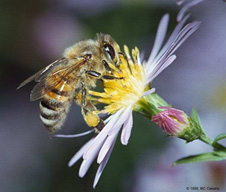 Study Links Bee Decline to Cell Phones. CNN Report - "Animals, including insects, use cryptochrome for navigation," Goldsworthy told CNN. "They use it to sense the direction of the earth's magnetic field and their ability to do this is compromised by radiation from [cell] phones and their base stations. So basically bees do not find their way back to the hive." Also look at this PDF file.
Study Links Bee Decline to Cell Phones. CNN Report - "Animals, including insects, use cryptochrome for navigation," Goldsworthy told CNN. "They use it to sense the direction of the earth's magnetic field and their ability to do this is compromised by radiation from [cell] phones and their base stations. So basically bees do not find their way back to the hive." Also look at this PDF file.
Honeybees’ Behavior Changes When Exposed to RF.
Safe Land for Bees. Barrie Trower, retired British military intelligence officer and microwave warfare expert, asks, "Will the Communications Industry be the final straw for Our Planet's Ecosystems?"
of magnetic, electric, and electromagnetic fields from numerous wireless technologies interfere with the natural information system and functioning of humans, animals, and plants. The consequences of this development, which have already been predicted by critics for many decades, cannot be ignored anymore. Bees and other insects vanish; birds avoid certain places and become disorientated at others. Humans suffer from functional impairments and diseases. And insofar as the latter are hereditary, they will be passed on to next generations as pre-existing defects." We are currently in the process of destroying in less than a few decades what nature took millions of years to create. In this brochure, he shows how nature uses much wisdom and sensitivity in employing electric as well as magnetic fields in the creation of life. Read more...
after the installation of cell phone towers and smart meters. Cytochrome P450 pathways are crucial to clearing toxins from the body. Glysophate interferes with those pathways. Many people who are electro-sensitive already have compromised CYP450 pathways. Glysophate chelates zinc, iron, manganese, and calcium, the 4 chemicals needed by us, other animals, and plants for a healthy body and immune system. See these links: 1, 2. Read more...
Ants
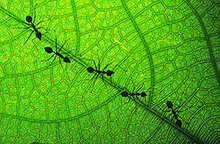 This study on ants regarding food collection and pheromones response showed that electromagnetic radiation causes ants to become confused and unable to collect food. Under the influence of electromagnetic radiation, ants followed trails for only short distances, no longer arrived at marked areas, no longer orientated themselves to a source of alarm pheromone, became unable to return to their nest and recruit congeners. Therefore, the number of ants collecting food increases only slightly and slowly. After 180 h of exposure, their colonies deteriorated.
This study on ants regarding food collection and pheromones response showed that electromagnetic radiation causes ants to become confused and unable to collect food. Under the influence of electromagnetic radiation, ants followed trails for only short distances, no longer arrived at marked areas, no longer orientated themselves to a source of alarm pheromone, became unable to return to their nest and recruit congeners. Therefore, the number of ants collecting food increases only slightly and slowly. After 180 h of exposure, their colonies deteriorated.
Earthworms
Oxidative and genotoxic effects of 900 MHz electromagnetic fields in the earthworm. Significant DNA-damaging capacity of 900 MHz electromagnetic radiation. Results indicated the induction of antioxidant stress response in terms of enhanced catalase and glutathione reductase activity as a result of the RF-EMF exposure, and demonstrated the generation of lipid and protein oxidative damage.
Birds
The Interior Department criticized the federal government's proposed procedures for placement and operation of communication towers, and called for "independent, third-party peer-reviewed studies" in the U.S. to examine the effects of cell tower radiation on "migratory birds and other trust species." It said the FCC standards are no longer appropriate because they control only for overheating and do not protect organisms from the adverse effects of exposure to the low-intensity radiation produced by cell phones and cell towers.
The Interior Department’s avers that the 30-year-old FCC standards are outmoded because it does not take into account the effects of lower levels of radiation output from microwave-powered communication devices such as cellular telephones and other sources of point-to-point communications (such as smart meters, which communicate point to point). It says that “very low levels of non-ionizing electromagnetic radiation” are a problem.
The letter from the Department of the Interior states in part: "There is a growing level of anecdotal evidence linking effects of non-thermal, non-ionizing electromagnetic radiation from communication towers on nesting and roosting wild birds and other wildlife in the U.S. Independent, third-party studies have yet to be conducted in the U.S. or Canada, although a peer-reviewed research protocol developed for the U.S. Forest Service by the Service's Division of Migratory Bird Management is available to study both collision and radiation impacts (Manville 2002). As previously mentioned, Balmori (2005) found strong negative correlations between levels of tower-emitted microwave radiation and bird breeding, nesting, and roosting in the vicinity of electromagnetic fields in Spain. He documented nest and site abandonment, plumage deterioration, locomotion problems, reduced survivorship, and death in House Sparrows, White Storks, Rock Doves, Magpies, Collared Doves, and other species.
Though these species had historically been documented to roost and nest in these areas, Balmori (2005) did not observe these symptoms prior to construction and operation of the cellular phone towers. Balmori and Hallberg (2007) and Everaert and Bauwens (2007) found similar strong negative correlations among male House Sparrows. Under laboratory 'conditions, DiCarlo et al. (2002) raised troubling concerns about impacts of low-level, non-thermal electromagnetic radiation from the standard 915 MHz cell phone frequency on domestic chicken embryos- with some lethal results (Manville 2009). Given the findings of the studies mentioned above, field studies should be conducted in North America to validate potential impacts of communication tower radiation—both direct and indirect —to migratory birds and other trust wildlife species."
The full text of the letter, the addendum, and citations are available at: http://1.usa.gov/1jn3CZg
A summarized version can be found at Electromagnetic Radiation Safety.
The press release is found here.
For more information, contact Joel M. Moskowitz, Ph.D., School of Public Health,
University of California, Berkeley.Read more...
Other Animals
The Interior Department criticized the federal government's proposed procedures for placement and operation of communication towers, and called for "independent, third-party peer-reviewed studies" in the U.S. to examine the effects of cell tower radiation on "migratory birds and other trust species." It said the FCC standards are no longer appropriate because they control only for overheating and do not protect organisms from the adverse effects of exposure to the low-intensity radiation produced by cell phones and cell towers.
The Interior Department’s avers that the 30-year-old FCC standards are outmoded because it does not take into account the effects of lower levels of radiation output from microwave-powered communication devices such as cellular telephones and other sources of point-to-point communications (such as smart meters, which communicate point to point). It says that “very low levels of non-ionizing electromagnetic radiation” are a problem.
The letter from the Department of the Interior states in part: "There is a growing level of anecdotal evidence linking effects of non-thermal, non-ionizing electromagnetic radiation from communication towers on nesting and roosting wild birds and other wildlife in the U.S. Independent, third-party studies have yet to be conducted in the U.S. or Canada, although a peer-reviewed research protocol developed for the U.S. Forest Service by the Service's Division of Migratory Bird Management is available to study both collision and radiation impacts (Manville 2002). As previously mentioned, Balmori (2005) found strong negative correlations between levels of tower-emitted microwave radiation and bird breeding, nesting, and roosting in the vicinity of electromagnetic fields in Spain. He documented nest and site abandonment, plumage deterioration, locomotion problems, reduced survivorship, and death in House Sparrows, White Storks, Rock Doves, Magpies, Collared Doves, and other species.
Though these species had historically been documented to roost and nest in these areas, Balmori (2005) did not observe these symptoms prior to construction and operation of the cellular phone towers. Balmori and Hallberg (2007) and Everaert and Bauwens (2007) found similar strong negative correlations among male House Sparrows. Under laboratory 'conditions, DiCarlo et al. (2002) raised troubling concerns about impacts of low-level, non-thermal electromagnetic radiation from the standard 915 MHz cell phone frequency on domestic chicken embryos- with some lethal results (Manville 2009). Given the findings of the studies mentioned above, field studies should be conducted in North America to validate potential impacts of communication tower radiation—both direct and indirect —to migratory birds and other trust wildlife species."
The full text of the letter, the addendum, and citations are available at: http://1.usa.gov/1jn3CZg
A summarized version can be found at Electromagnetic Radiation Safety.
The press release is found here.
For more information, contact Joel M. Moskowitz, Ph.D., School of Public Health,
University of California, Berkeley.Read more...
Newsletter, Facebook—Stay Up to Date
Stay up to date by subscribing to our newsletter (it comes out every 1 to 4 weeks). We constantly update our website, so check back often. You can find updates and time-sensitive actions to take under our “Alerts and Breaking News” box. We also use Facebook to send out quick news updates. (While we understand the privacy concerns with Facebook, at this point in time it is a useful tool for us, and is a great way to spread the word about smart meters. If you only wish to use Facebook for access to our updates, you can get an account without revealing personal information—it’s all in what you choose to share, and you can give them any name or birthdate you like.)
Our newsletter comes out every 1 to 4 weeks. It will keep you informed and tell you what actions you can take to fight smart meters. Note that most email programs will filter out our newsletter unless you adjust your email settings. Even though you may receive individual emails from us, when we send the newsletter out to a large group, the emails may be placed in a folder other than your inbox. This happened to us! We weren’t even getting our own newsletter.. Please make sure you look for emails from smartmetereducationnetwork@ gmail. com in your Promotions, Spam, Junk, or other folders. Please contact your email provider to learn how to adjust your settings, or search on the internet.
Terms to Know
Advanced meter: smart meter (term used by DTE to hide the fact it is a smart meter).
AMI meter and AMI program: another name for the smart meter and the smart meter program. AMI stands for advanced metering infrastructure.
Blood-brain barrier: EMFs can cause the blood-brain barrier to be breached, allowing toxins to enter the brain. Toxin entry is thought to be partially responsible for Alzheimer’s, dementia, and Parkinson’s.
Dirty electricity: spiky, pulsed electromagnetic field generated by smart meters that rides through building wiring and permeates the building’s rooms. Responsible for many of the health problems seen with smart and digital meters.
Electromagnetic fields (EMFs): consist of an electrical field and a magnetic field. Fields are created by the flow of electrical current through the wire, sunlight, etc.
Electromagnetic frequency: examples are 60 Hz electrical current of your home, RF of a cell phone. Often used interchangeably with electromagnetic field.
Electromagnetic hypersensitivity (EHS): sensitivity to electromagnetic fields. Symptoms are complex and involve all bodily systems
Hydrogen bonds: Electrostatic bonds that help hold the DNA double helix together. Breakage of hydrogen bonds may cause changes in DNA that can lead to cancer. RF and other EMFs may disrupt the Hydrogen bonds.
Meter upgrade: the installation of an advanced (smart) meter on your home by DTE.
Microwave radiation: the type of radiation emitted by smart meters. Known to cause biological harm.
Non-transmitting meter: another name for the DTE and Consumers opt-out meters.
Opt-out meter: this is a smart meter. The only thing that is different is the radio-transmitter is turned off. It still generates dirty electricity, it still retains the two antennas, and it is only incrementally less harmful to your health. It can still record detailed information about your electrical usage.
Radio-disabled meter: another name for the DTE opt-out meter.
Radio-off meter: another name for the DTE opt-out meter.
Radiofrequency (RF): high-frequency electromagnetic waves in the range of 10 MHz to 300 Ghz. All wireless devices, including smart meters, cell phones, and Wi-Fi emit RF.
Switched mode power supply: contained in all smart meters, it creates dirty electricity.
van der Waals bonds: an extremely weak electromagnetic force that helps hold the DNA double helix together. Breakage of the van der Waals bond may cause changes in DNA that can lead to cancer. RF and other EMFs can disrupt the van der Waals bonds.

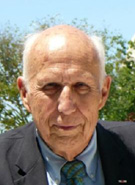
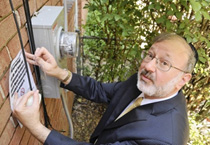
 Food Plants Affected by Microwave Radiation from Wireless Devices
Food Plants Affected by Microwave Radiation from Wireless Devices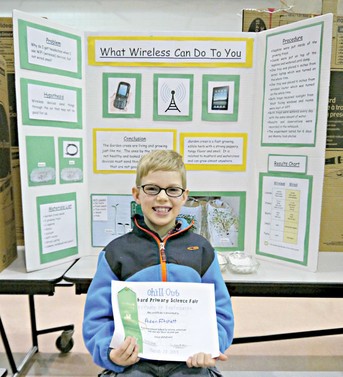 An eight-year-old boy in Almont, Michigan was getting severe headaches when seated near the wireless projector in his classroom. They were so severe, he would come home crying from the pain. When he was seated away from the projector, his headaches stopped. For many people, who are even more sensitive than he is, increased distance from wireless device does not help, because the radiation is permeating the environment around them. See this series of
An eight-year-old boy in Almont, Michigan was getting severe headaches when seated near the wireless projector in his classroom. They were so severe, he would come home crying from the pain. When he was seated away from the projector, his headaches stopped. For many people, who are even more sensitive than he is, increased distance from wireless device does not help, because the radiation is permeating the environment around them. See this series of  Department of the Interior: Cell Tower Microwave Radiation Has Negative Impact on Birds. Cell tower radiation has had negative impacts on the health of migratory birds and other wildlife, said the Department of the Interior, in a strongly worded
Department of the Interior: Cell Tower Microwave Radiation Has Negative Impact on Birds. Cell tower radiation has had negative impacts on the health of migratory birds and other wildlife, said the Department of the Interior, in a strongly worded